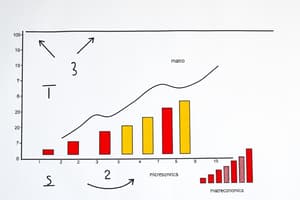Podcast
Questions and Answers
Which economic theory prioritizes the self-regulation of markets?
Which economic theory prioritizes the self-regulation of markets?
- Classical Economics (correct)
- Behavioral Economics
- Keynesian Economics
- Monetarist Theory
Which issue is primarily concerned with how wealth is distributed across different groups?
Which issue is primarily concerned with how wealth is distributed across different groups?
- Sustainability
- Income Inequality (correct)
- Inflation Rates
- Globalization
What concept is associated with the idea that lower taxes and deregulation can spur production?
What concept is associated with the idea that lower taxes and deregulation can spur production?
- Neoclassical Economics
- Keynesian Economics
- Classical Economics
- Supply-Side Economics (correct)
Which concept involves the idea of integrating environmental protection with economic growth?
Which concept involves the idea of integrating environmental protection with economic growth?
Which economic aspect emphasizes the government's role in boosting economic demand?
Which economic aspect emphasizes the government's role in boosting economic demand?
What is the primary focus of microeconomics?
What is the primary focus of microeconomics?
What does the term 'opportunity cost' refer to?
What does the term 'opportunity cost' refer to?
Which market structure is characterized by a single seller with high barriers to entry?
Which market structure is characterized by a single seller with high barriers to entry?
What is one key tool used in fiscal policy?
What is one key tool used in fiscal policy?
Which of the following is NOT a characteristic of perfect competition?
Which of the following is NOT a characteristic of perfect competition?
What best describes the inflation rate?
What best describes the inflation rate?
What is one potential barrier to trade?
What is one potential barrier to trade?
What determines the value of one currency relative to another?
What determines the value of one currency relative to another?
Study Notes
Economic Concepts
- Definition: Economics is the study of how individuals, businesses, governments, and nations make choices about allocating resources.
Key Areas of Economics
-
Microeconomics:
- Focuses on individual agents (consumers and firms).
- Examines supply and demand, pricing, and competition.
- Key concepts: Elasticity, consumer surplus, producer surplus.
-
Macroeconomics:
- Studies aggregate economic phenomena.
- Includes inflation, unemployment, GDP, and fiscal policies.
- Key concepts: Economic growth, business cycles, monetary policy.
Fundamental Economic Principles
- Scarcity: Limited resources versus unlimited wants.
- Opportunity Cost: Cost of the next best alternative forgone.
- Supply and Demand: Determines price levels in a market.
- Demand shifts: Changes in consumer preferences, income levels, and price of substitutes.
- Supply shifts: Changes in production costs, technology, and number of suppliers.
Market Structures
-
Perfect Competition:
- Many buyers and sellers.
- Homogeneous products.
- No barriers to entry.
-
Monopoly:
- Single seller dominant in the market.
- High barriers to entry.
- Price maker without close substitutes.
-
Oligopoly:
- Few sellers dominating the market.
- Products may be similar or differentiated.
- Interdependence among firms (e.g., price wars).
-
Monopolistic Competition:
- Many sellers.
- Differentiated products.
- Some control over pricing.
Economic Indicators
- Gross Domestic Product (GDP): Total value of all goods and services produced in a country.
- Unemployment Rate: Percentage of the labor force that is unemployed and actively seeking work.
- Inflation Rate: Measures the rate at which the general price level of goods and services is rising.
Fiscal and Monetary Policy
-
Fiscal Policy:
- Government's use of spending and taxation to influence the economy.
- Tools: Government budgets, tax policy.
-
Monetary Policy:
- Central bank's management of money supply and interest rates.
- Tools: Open market operations, discount rate, reserve requirements.
International Economics
-
Trade:
- Benefits: Comparative advantage leads to increased efficiency.
- Barriers: Tariffs, quotas, and subsidies impacting trade.
-
Exchange Rates:
- Determine the value of one currency relative to another.
- Influenced by interest rates, economic stability, and inflation.
Economic Theories
- Classical Economics: Focused on free markets and the idea that markets self-regulate.
- Keynesian Economics: Emphasizes the role of government in stimulating economic demand.
- Supply-Side Economics: Advocates for lower taxes and deregulation to encourage production.
Current Economic Issues
- Income Inequality: Examines the distribution of wealth among individuals and groups.
- Globalization: The increasing interdependence of world economies.
- Sustainability: Balancing economic growth with environmental protection.
Conclusion
- Understanding economics is essential for making informed decisions in personal finance, business, and policy-making. The field encompasses various theories, principles, and real-world applications influencing daily life and global interactions.
Economics: The Study of Choice
- Economics analyzes how individuals, businesses, governments, and nations make choices with limited resources.
- It explores how individuals, businesses, and governments make decisions to achieve their objectives.
- It encompasses both microeconomics and macroeconomics.
Microeconomics: Individual Decision-Making
- Microeconomics examines individual agents, such as consumers and firms, and their interactions in markets.
- It focuses on the supply and demand of specific goods and services, pricing, and competition.
- Key concepts include elasticity (measuring the sensitivity of demand and supply to price changes), consumer surplus (gain consumers receive), and producer surplus (gain producers receive).
Macroeconomics: The Big Picture
- Macroeconomics delves into the overall performance of the economy, analyzing aggregate indicators.
- It studies inflation, unemployment, gross domestic product (GDP), and government policies.
- Key concepts include economic growth, business cycles, monetary policy.
Scarcity: The Fundamental Constraint
- Scarcity is the core principle of economics, reflecting the contrast between limited resources and unlimited wants.
- Every choice has a cost, and the opportunity cost is the value of the next best alternative forgone.
Supply and Demand: The Market Mechanism
- The interplay of supply and demand determines the prices of goods and services in a market.
- Demand shifts when factors like consumer preferences, income levels, and prices of substitutes change.
- Supply shifts occur due to changes in production costs, technology, and the number of suppliers.
Market Structures: Different Forms of Competition
- Perfect competition represents a theoretical market with many buyers and sellers, homogeneous products, and no barriers to entry.
- Monopoly entails a single seller dominating the market with high barriers to entry, allowing the firm to set prices without competition.
- Oligopoly involves a few sellers dominating the market, with products that may be similar or differentiated. These firms are interdependent, influencing each other's pricing and output decisions.
- Monopolistic competition involves many sellers offering differentiated products, giving them some control over pricing.
Measuring Economic Performance: Key Indicators
- The Gross Domestic Product (GDP) measures the total value of goods and services produced in a country.
- The unemployment rate signifies the percentage of the labor force actively seeking work but unable to find it.
- The inflation rate gauges the rate at which the general price level of goods and services rises.
Government Intervention: Fiscal and Monetary Policy
- Fiscal policy refers to the government's actions, including spending and taxation, to influence the economy.
- Monetary policy involves the central bank's management of the money supply and interest rates.
International Economics: Global Interdependence
- International trade allows countries to specialize in producing goods and services in which they have a comparative advantage, leading to increased efficiency.
- Trade barriers, like tariffs, quotas, and subsidies, can impact the flow of goods between countries.
- Exchange rates determine the relative value of one currency compared to another, influenced by interest rates, economic stability, and inflation.
Different Economic Perspectives: Theories and Debates
- Classical economics emphasizes free markets and the idea that they self-regulate.
- Keynesian economics highlights the role of government in stimulating economic demand to address unemployment and recessions.
- Supply-side economics advocates for lower taxes and deregulation to encourage production and economic growth.
Contemporary Economic Challenges
- Income inequality refers to the uneven distribution of wealth and income within societies.
- Globalization reflects the increasing interdependence of world economies through trade, investment, and technological advancements.
- Sustainability encompasses balancing economic growth with environmental protection and resource conservation.
The Importance of Economics
- Understanding economics is crucial for making informed decisions in personal finance, business, and policy-making.
- It helps us navigate global economic challenges and fosters a deeper understanding of social and political issues.
Studying That Suits You
Use AI to generate personalized quizzes and flashcards to suit your learning preferences.
Description
This quiz covers the basic principles of economics, including both microeconomics and macroeconomics. Explore key areas such as supply and demand, scarcity, and opportunity cost. Test your understanding of fundamental economic theories and concepts.




